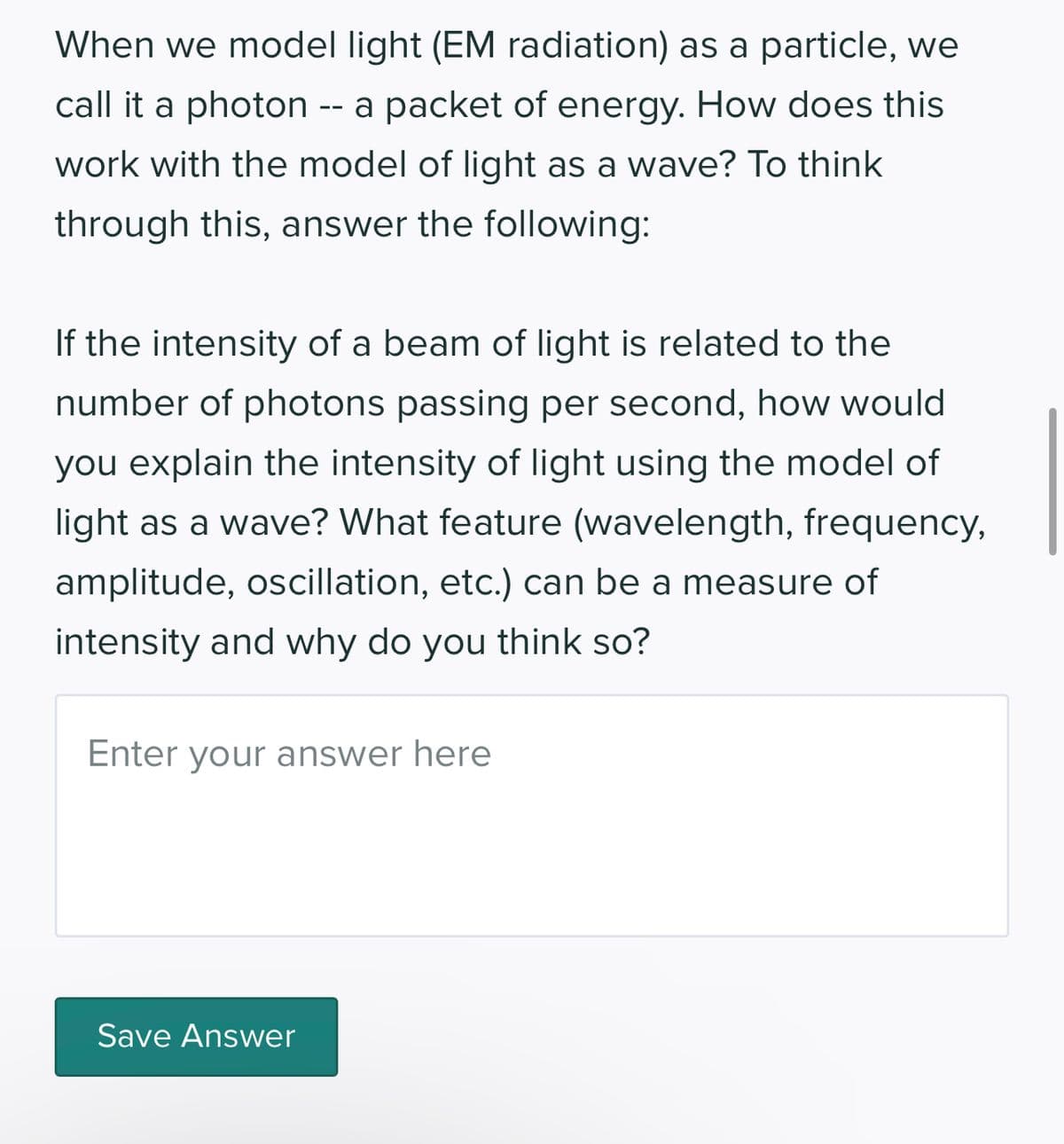When we model light (EM radiation) as a particle, we call it a photon -- a packet of energy. How does this work with the model of light as a wave? To think through this, answer the following: If the intensity of a beam of light is related to the number of photons passing per second, how would you explain the intensity of light using the model of light as a wave? What feature (wavelength, frequency, amplitude, oscillation, etc.) can be a measure of intensity and why do you think so?
When we model light (EM radiation) as a particle, we call it a photon -- a packet of energy. How does this work with the model of light as a wave? To think through this, answer the following: If the intensity of a beam of light is related to the number of photons passing per second, how would you explain the intensity of light using the model of light as a wave? What feature (wavelength, frequency, amplitude, oscillation, etc.) can be a measure of intensity and why do you think so?
Principles of Modern Chemistry
8th Edition
ISBN:9781305079113
Author:David W. Oxtoby, H. Pat Gillis, Laurie J. Butler
Publisher:David W. Oxtoby, H. Pat Gillis, Laurie J. Butler
Chapter5: Quantum Mechanics And Atomic Structure
Section: Chapter Questions
Problem 28P: Quantum mechanics predicts that the energy of the ground state of the H atom is 13.6eV . Insight...
Related questions
Question

Transcribed Image Text:When we model light (EM radiation) as a particle, we
call it a photon -- a packet of energy. How does this
work with the model of light as a wave? To think
through this, answer the following:
If the intensity of a beam of light is related to the
number of photons passing per second, how would
you explain the intensity of light using the model of
light as a wave? What feature (wavelength, frequency,
amplitude, oscillation, etc.) can be a measure of
intensity and why do you think so?
Enter your answer here
Save Answer
Expert Solution
This question has been solved!
Explore an expertly crafted, step-by-step solution for a thorough understanding of key concepts.
This is a popular solution!
Trending now
This is a popular solution!
Step by step
Solved in 2 steps

Knowledge Booster
Learn more about
Need a deep-dive on the concept behind this application? Look no further. Learn more about this topic, chemistry and related others by exploring similar questions and additional content below.Recommended textbooks for you

Principles of Modern Chemistry
Chemistry
ISBN:
9781305079113
Author:
David W. Oxtoby, H. Pat Gillis, Laurie J. Butler
Publisher:
Cengage Learning

Chemistry: Principles and Reactions
Chemistry
ISBN:
9781305079373
Author:
William L. Masterton, Cecile N. Hurley
Publisher:
Cengage Learning


Principles of Modern Chemistry
Chemistry
ISBN:
9781305079113
Author:
David W. Oxtoby, H. Pat Gillis, Laurie J. Butler
Publisher:
Cengage Learning

Chemistry: Principles and Reactions
Chemistry
ISBN:
9781305079373
Author:
William L. Masterton, Cecile N. Hurley
Publisher:
Cengage Learning


Physical Chemistry
Chemistry
ISBN:
9781133958437
Author:
Ball, David W. (david Warren), BAER, Tomas
Publisher:
Wadsworth Cengage Learning,

Chemistry: Principles and Practice
Chemistry
ISBN:
9780534420123
Author:
Daniel L. Reger, Scott R. Goode, David W. Ball, Edward Mercer
Publisher:
Cengage Learning

Chemistry
Chemistry
ISBN:
9781305957404
Author:
Steven S. Zumdahl, Susan A. Zumdahl, Donald J. DeCoste
Publisher:
Cengage Learning